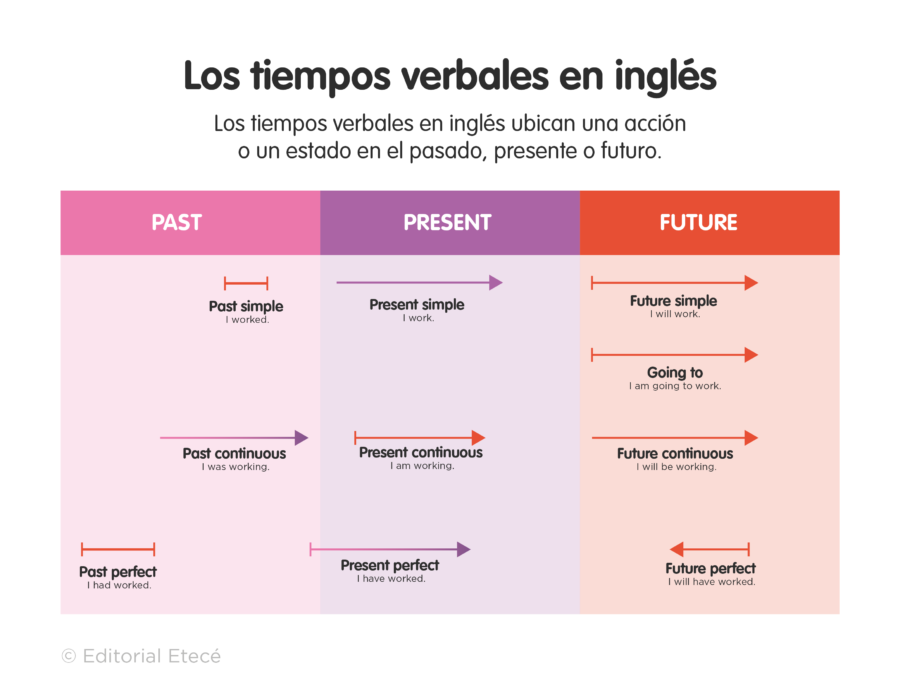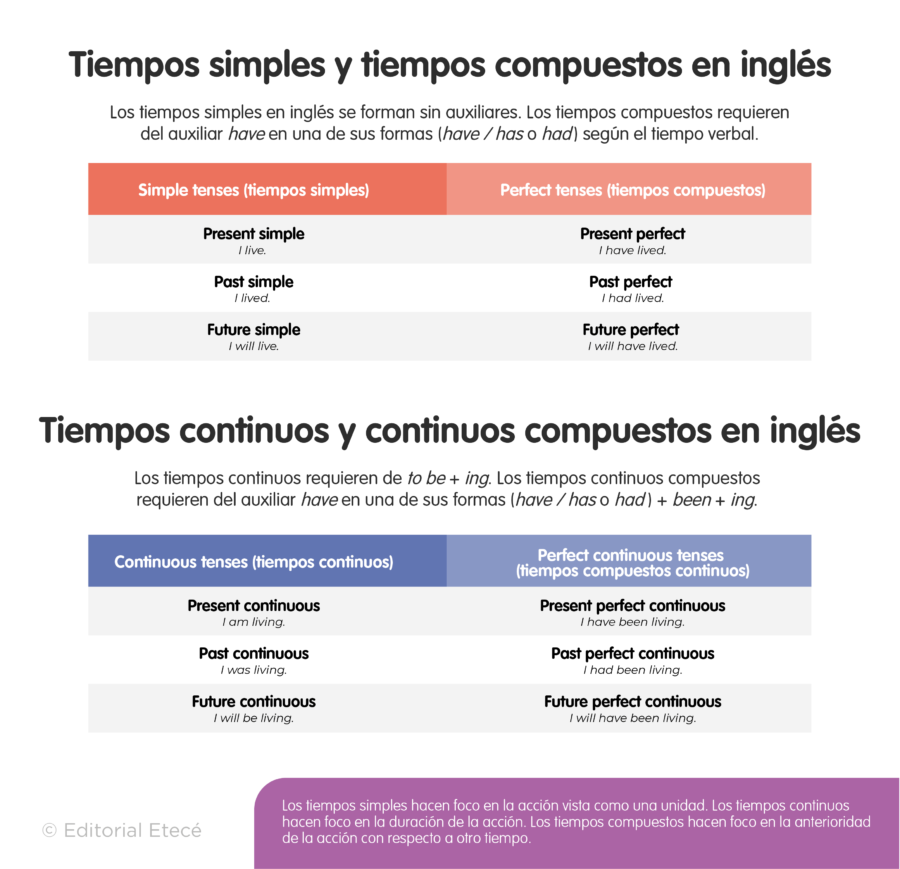El present continuous (o present progressive) es un tiempo verbal en inglés que se utiliza para expresar acciones que están ocurriendo en este momento. Por ejemplo: I am speaking on the phone right now. / Estoy hablando por teléfono en este momento.
El present continuous (presente continuo) es un tiempo verbal compuesto, ya que se compone de dos partes: un auxiliar (verbo to be en presente) + la forma -ing del verbo principal. Por ejemplo: My sister is studying in her bedroom. / Mi hermana está estudiando en su habitación.
Para tener en cuenta: Mientras que el present simple describe acciones o estados permanentes, el present continuous expresa acciones temporarias. Por ejemplo:
- I work for an international company. / Trabajo para una compañía internacional. (present simple: acción permanente)
- I am working on a special project at the moment. / Estoy trabajando en un proyecto especial en este momento. (present continuous: acción temporaria)
- Puede servirte: Verbos en gerundio en inglés

Usos del present continuous
El present continuous se utiliza para expresar:
- Acciones que están sucediendo en el momento. Por ejemplo: I’m having lunch. / Estoy almorzando.
- Actividades en progreso en el presente, aunque no necesariamente en el momento. Por ejemplo: He is reading a good book. / Está leyendo un buen libro.
- Eventos futuros. Eventos agendados, en general, con día y horario. Es el único uso futuro (y no presente) del present continuous. Por ejemplo: My mother is flying to Amsterdam on December 10. / Mi mamá va a viajar a Amsterdam el 10 de diciembre.
Cuidado: La forma -ing del verbo por sí sola no es el present continuous. Por ejemplo: I am having a shower. (Y no: I having a shower).
- Puede servirte: Futuro simple en inglés
Estructura del present continuous
El present continuous es un tiempo verbal compuesto, es decir, tiene dos partes: el auxiliar, que es el verbo to be en presente (am, is, are) según el pronombre + la forma –ing del verbo principal (playing).
Estructura afirmativa del present continuous
| Sujeto | Auxiliar to be (presente) | verbo en ing |
|---|---|---|
| I | am (‘m) | walking |
| He She It | is (‘s) | |
| You We They | are (‘re) |
Por ejemplo: I am reading “The Lord of the Rings”. / Estoy leyendo “El Señor de los Anillos”.
Atención:
- En el lenguaje oral y escrito (excepto en estilo formal) se usa la forma contraída del verbo to be. Por ejemplo: He’s preparing dinner. / Él está preparando la cena.
- Los verbos terminados en “e” la pierden antes de agregar la terminación -ing (come – coming; dance – dancing). Los monosílabos doblan la consonante antes de agregar la terminación -ing (run – running; sit – sitting).
Estructura negativa del present continuous
La estructura negativa se forma negando el auxiliar to be (con la partícula not):
| Sujeto | Auxiliar to be (negativo) | verbo en ing |
|---|---|---|
| I | am not (‘m not) | eating |
| He She It | is not (isn’t) | |
| You We They | are not (aren’t) |
Por ejemplo: I’m not crying. / No estoy llorando.
Estructura interrogativa del present continuous
La estructura interrogativa se forma anteponiendo el auxiliar to be al sujeto:
| Auxiliar to be | Sujeto | verbo en ing |
|---|---|---|
| Am | I | listening? |
| Is | he she it | |
| Are | you we they |
Por ejemplo: Are you listening to the radio? / ¿Estás escuchando la radio?
Atención: Si se quiere obtener información (y no un “sí” o un “no” como respuesta) se debe agregar una palabra wh (what, when, where, why, who, how, which) antes del auxiliar. Por ejemplo: What are you watching? / ¿Qué estás mirando?
Respuestas cortas
Para responder yes-no questions, se utiliza el verbo to be en positivo o en negativo, y según el pronombre. Las respuestas cortas afirmativas no se pueden contraer. No se repite el verbo principal. Por ejemplo: Are you working? Yes, I am. (Y no: Yes, I’m working).
- Puede servirte: Oraciones con “going to”
Present continuous: Adverbios de tiempo
Algunos adverbios de tiempo que se utilizan junto al present continuous según cada uso son:
| Uso | Adverbios | Ejemplos |
|---|---|---|
| Para expresar acciones que están sucediendo en el momento de habla. | now (ahora) right now (ahora mismo) at the moment (en este momento) | I’m working right now. / Estoy trabajando ahora mismo. |
| Para expresar actividades en progreso en el presente, aunque no necesariamente en el momento | this week (esta semana) these days (estos días) this month (este mes) | We’re spending less money this month. / Estamos gastando menos dinero este mes. |
| Para expresar eventos futuros agendados | on September 21st. (el 21 de septiembre) at 5 p.m. tomorrow (mañana a las 5 p.m.) next week (la semana próxima) | They’re setting off at 9 a.m. / Ellos van a partir mañana a las 9 a.m. |
- Puede servirte: Preposiciones de tiempo «in», «on», «at»
Present continuous y present simple
| PRESENT SIMPLE | PRESENT CONTINUOUS |
|---|---|
| Expresa acciones o estados permanentes en el presente. Sarah lives in Buenos Aires. | Expresa acciones temporarias. Sarah is living with some friends before moving to a new house. |
| Expresa rutina. Every day I get up at 7 a.m. | Expresa excepción a una rutina. I’m getting up at 8 a.m. this week. |
| Expresa acciones que ocurren siempre. I always wait for the bus here. | Expresa acciones que ocurren en el momento. I’m waiting for the bus. |
| Expresa eventos futuros. My friends are coming over for dinner tonight. |

Atención:
- Existen los stative verbs (verbos “estáticos”), tales como believe, know, mean, understand, cost que se utilizan solo en present simple. No pueden ser utilizados en present continuous ni en ningún otro tiempo continuo, debido a que expresan condiciones y estados (y no acciones o actividades). Por ejemplo: It costs $10. (Y no: It is costing $10).
- El present continuous siempre implica que una acción es temporaria. Para describir situaciones continuas y permanentes que empezaron en el pasado y continúan, se utiliza present perfect continuous. Por ejemplo: My father has been working at this company for 15 years. (Y no: My father is working at this company for 15 years).
- Ver también: Presente simple en inglés
Ejemplos de oraciones en present continuous
- I’m having a great time; this party is awesome!
¡Me estoy divirtiendo mucho; esta fiesta es increíble! - They are painting the house next door.
Están pintando la casa de al lado. - My mom is cooking a delicious dish for dinner.
Mi mamá está cocinando un plato delicioso para la cena. - Jim is making good progress.
Jim está haciendo un buen progreso. - The teacher is coming!
¡Está llegando la maestra! - John is reading a very good book.
John está leyendo un muy buen libro. - Susan is learning a lot in her new course.
Susan está aprendiendo mucho en su nuevo curso. - The kids are jumping on the bed.
Los niños están saltando sobre la cama. - I am relaxing at the park.
Me estoy relajando en el parque. - The students aren’t paying attention.
Los estudiantes no están prestando atención. - The sun is shining and the birds are singing.
El sol está brillando y los pájaros están cantando. - Excuse me, madam, are you waiting in line?
Disculpe señora, ¿está esperando en la fila? - Those men are not speaking German.
Esos hombres no están hablando alemán. - I am studying for tomorrow’s test.
Estoy estudiando para el examen de mañana. - Meryl and Tom are doing the house chores.
Meryl y Tom están haciendo las tareas del hogar. - Dad is watering the plants in the backyard.
Papá está regando las plantas en el patio trasero. - Peter is playing with his friends in the garden.
Peter está jugando con sus amigos en el jardín. - His brother is climbing that tree.
Su hermano está trepando aquel árbol. - The dogs are barking outside.
Los perros están ladrando afuera. - I’m not lying!
¡No estoy mintiendo! - It isn’t snowing; it’s just raining.
No está nevando; solo está lloviendo. - My sister is learning how to drive.
Mi hermana está aprendiendo a conducir. - The firemen are trying to stop the fire in that building.
Los bomberos están tratando de apagar el incendio en aquel edificio. - We are watching a good movie on television.
Estamos mirando una buena película en televisión. - Sandy’s parents are working on a new project at the moment.
Los padres de Sandy están trabajando en un nuevo proyecto. - The teacher is writing the explanations on the board.
La profesora está escribiendo las explicaciones en el pizarrón. - My dog is playing with a ball.
Mi perro está jugando con una pelota. - You’re not following the instructions carefully.
No estás siguiendo las instrucciones cuidadosamente. - The meal is burning!
¡Se está quemando la comida! - Thomas is adapting to his new life in Rome.
Thomas se está adaptando a su nueva vida en Roma. - They are looking at the photos from her last trip to the United States.
Están mirando las fotos de su último viaje a Estados Unidos. - The children are playing in the school yard during the break.
Los niños están jugando en el patio de la escuela durante el receso. - Ariana Grande is recording a new album.
Ariana Grande está grabando un nuevo álbum. - You are driving too fast!
¡Estás manejando demasiado rápido! - Someone is knocking at the door.
Alguien está llamando a la puerta. - Mel and Stan are getting to know each other.
Mel y Stan se están conociendo. - She’s studying physics at university.
Está estudiando física en la universidad. - My family is planning a trip to Disney.
Mi familia está planeando un viaje a Disney. - The phone is ringing; can you get it?
El teléfono está sonando; ¿puedes atenderlo? - We are going on vacation next week.
Nos vamos a ir de vacaciones la semana que viene. - Are you coming to visit us in July?
¿Vas a venir a visitarnos en julio? - The boy is not crying because his toy is broken.
El niño está llorando porque su juguete está roto. - The plane is not leaving the airport, because it’s still raining heavily.
El avión no está dejando el aeropuerto porque todavía está lloviendo fuertemente. - They are drinking tea with cake.
Están tomando un té con torta. - My friends are taking an English course at the moment.
Mis amigos están tomando un curso de inglés en este momento. - She isn’t sleeping well these days.
No está durmiendo bien en estos días. - More and more people are becoming vegetarian.
Cada vez más gente se está volviendo vegetariana. - I am watching the news on TV.
Estoy mirando las noticias en la TV. - Mary’s currently looking for a job.
Mary está buscando trabajo actualmente. - Is Matt going to the movies tonight?
¿Matt va ir al cine esta noche?
Sigue con:
- Oraciones en pasado continuo (inglés)
- Oraciones con «will» y «going to»
- Oraciones en presente perfecto en inglés
- Verbos en inglés y en español
¿Te fue útil esta información?
Sí No¡Genial! gracias por visitarnos :)